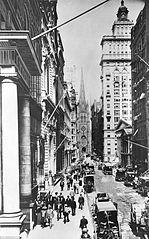“Money, again, has often been a cause of the delusion of multitudes. Sober nations have all at once become desperate gamblers, and risked almost their existence upon the turn of a piece of paper.”
– Charles Mackay, Extraordinary Popular Delusions And The Madness Of Crowds, 1841.

Economic bubbles are great examples of societies failing to learn from previous mistakes. Time and time again something comes along that seems too good to be true and it inevitably turns out that it is. People invest in their masses and the more who invest, the higher the price rises, drawing more people in until eventually the bottom falls out and people lose a lot, sometimes everything.
Bubbles in nature are simple, perfect and beautiful. Investment bubbles can seem the same way at the beginning – perfect and so beautifully simple. You put money in and it grows, what could be easier or more rewarding than that? Nature’s bubbles are incredibly delicate though and are all destined to eventually pop, gone forever. Economic bubbles are the same, but it takes a while for people to see how fragile they are, often not before it is too late.
Outlined below are 4 major bubbles from the past 400 years, taking in bubbles surrounding individual companies, whole industries and entire national economies.
Tulip Mania

One of the earliest examples of a bubble occurred in the Dutch Republic in the 1630s. It concerned the trade of tulip bulbs, or more specifically the trade of agreements to buy tulip bulbs, essentially what we would refer to as futures contracts today.
Tulips flower in mid-Spring, with their bulbs becoming dormant and ready for harvesting around June. The bulbs stay dormant until September, after which they must be planted. This meant that the sale of bulbs could only occur between June and September, with agreements to buy bulbs (rather than the bulbs themselves) changing hands the rest of the year.
New varieties of stripy petalled tulips started to appear in the early 1630s and as they popularity grew speculators started to move in. By 1636 contracts for single bulbs were changing hands for many multiples of average yearly salaries, with some contracts changing hands dozens of times a day. Many people made huge fortunes having never even laid eyes on the tulip bulbs their agreements were backed by.
Trade was not confined to financiers and bankers, many regular people were drawn into the whirlwind of sky-rocketing prices, believing that the rich from all over the world would soon be coming to Holland to pay huge sums for tulips and that demand would never cease.
Bulb prices peaked in February 1637 with reports of a single bulb being purchased for 100,000 (florins the equivalent of around £1million in today’s money) then dipped suddenly, after which trading quickly ground to a halt, financially ruining huge numbers of people.
It’s worth noting that short selling was a practice banned in the Dutch Republic at the time, making it very hard for investors to re-coup any losses as the tulip prices started their inexorable decline.
The South Sea Bubble

Around 75 years later, in 1711, the South Sea Company was founded in Britain, ostensibly as a monopolistic trading company for commerce with South America. The company never did much trade in that regard though due to the Spain’s grip on the continent and the ongoing War of Spanish Succession. Instead, the company was used as a vehicle for consolidating Britain’s national debt. Those whom the nation owed a monetary debt were given shares of equal value in the newly formed company with a dividend (paid by the government, rather than the company).
This resulted in potentially lower returns for the holders of the relatively risk free national debt, but turned an illiquid market liquid, allowing the debt to be freely traded as shares.
In 1719 a scheme was hatched for the South Sea Company to take on more government debt in return for shares, around £2.5million worth. Such was the success of this refinancing that the government decided to repeat the process, hoping to pass over most of the national debt, approximately £31million.
After this, in early 1720, the already bloated company set about putting rumours about of the potential riches to be gathered in South America using their monopoly. The speculators dove straight in, boosting the share price from £120 to £550 by May. The company itself started lending money to speculators to buy shares in order to artificially inflate the price. By early August the share price had nearly hit £1,000 and it came time for the company to reclaim the money it had lent.
Many speculators were only able to pay back their debts by selling their South Sea shares, causing a sudden drop in the share price. Many investors who had bought near the top on credit were now sorely out of pocket, forcing them to sell their holdings for a loss and forcing the price down even further. By the end of the year the share price had fallen to £100 with many investors bankrupt or nursing serious dents to their fortunes.
Wall Street Crash

As the 1920s drew to a close in the USA the Great Depression was kicked off by the largest stock market crash in US history. The Dow Jones Industrial Average peaked at just over 381 points on 3 September 1929, but by 13 November had hit 198, a fall of 42%. By 8 July 1932 the Dow had slipped down to just above 41 points, a slide of over 91% from its high. What happened?
As with the two examples outlined above, the bursting of the bubble was preceded by rife speculation, first by financial professionals, but soon by an increasing proportion of the general populace.
Technological advances created new products, companies and industries in the 1920s and generated a mood of optimism. Many Americans became stockholders who had previously never dabbled in the markets. As prices started to rise and paper profits rose accordingly many borrowed money to invest in shares or took on large margins to maximise profit. At one point more money has been loaned for purchasing shares than there was hard currency in the country, over $8billion.
Panic selling started on Black Thursday, 24 October 1929, with the ow dropping 11% in one day. This was followed by two further major falls, 13% on 28 October and 12% on 29 October. Margin calls came in and speculators, both financiers and private individuals lost huge sums of money.
The Dot Com Bubble
An entirely new industry sprang up in the late 1990s consisting of companies focussed on the internet, collectively known as dot coms. In a strange twist to the standard bubble arc, investors were seemingly unfazed by the lack of profit these companies showed, in fact some companies would go to initial public offering having only ever made large losses.
A large number of these companies were focussed on rapid growth in the new industry, putting profits as a secondary requirement to be fulfilled further down the line. The mantra of the day was “get large or get lost”. investors bought into this in a way that would unlikely ever have done in other, more established industries. As with the examples above, the speculators moved in and share prices began to rise and rise.
The US Federal Reserve increased interest rates significantly between mid 1999 and early 2000 causing the US economy to slow down. In turn, dot com share prices began to falter. Many companies were listed on the NASDAQ Composite which peaked at 5,048.62 on 10 March 2000 falling to only 1,114.11 on 9 October 2002.
Future bubbles
History has shown us the same pattern repeated in each of the bubbles above. New ideas creating initial optimism and wealth but turning to depression and severe hardship as things get out of control. Doubtless this pattern will be repeated again in the future, probably many times.
It is often hard to see the signs of a bubble until it is too late, but if you take a step back and look at recent developments in new ideas like Bitcoin, or the seemingly endless rise in London house prices you might see certain correlations. Keep an eye out and invest wisely.
“In the present state of civilization, society has often shown itself very prone to run a career of folly from the last-mentioned cases. This infatuation has seized upon whole nations in a most extraordinary manner.” – Charles Mackay, 1841

 Hot Features
Hot Features













